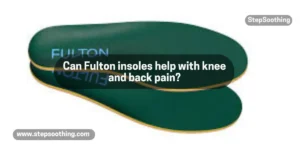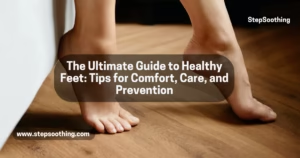Many people use insoles to improve the comfort and support of their shoes, but what happens when one pair isn’t enough? Can you wear two pairs of insoles to enhance cushioning or improve shoe fit? Some people experiment with stacking insoles for extra comfort, while others use them to adjust shoe size. The idea seems helpful, but is it really the best solution?
I once tried inserting two pairs of insoles in my running shoes, hoping for enhanced comfort. Instead, my feet felt tighter, and after a few weeks, I developed blisters. While doubling up might work for some, it’s important to understand both the benefits and risks before making a decision.
Wearing Two Insoles: The Surprising Truth!

Reasons for Wearing Two Pairs of Insoles
Some people wear two pairs of insoles to enhance comfort by adding an extra padded layer. Those with flat feet or high arches may need extra arch support to align their feet properly and reduce pressure on their joints. For people with plantar fasciitis, extra cushy insoles can provide much-needed relief by absorbing impact.
Another common reason is adjustment for shoe size. If a pair of shoes feels slightly bigger, placing extra insoles inside can make them fit more comfortably. I remember buying boots that were slightly too big, and a second insole was an effective fix without having to replace them.
Potential Issues with Wearing Two Insoles
A. Fit & Comfort Issues
Wearing multiple insoles might seem like a good idea, but it can create problems. Adding extra layers can make the shoes feel tighter, leaving less room for the toes, which may lead to discomfort or even crushing. I once tried this with my work boots, and after standing for prolonged periods, my feet were aching due to the reduced breathability.
Another issue is that stacked insoles may move around instead of staying securely in place. The process of finding the correct positioning can be tedious, and if not properly placed, it may result in slippage, making walking uncomfortable.
B. Health & Performance Risks
Using two pairs of insoles can sometimes affect foot alignment and change how the footbed interacts with the ground. This can cause an unbalanced gait, leading to pain in the hips, knees, or lower limbs. Some people have even reported that it aggravated existing issues instead of solving them.
There’s also the risk of developing blisters due to rubbing, especially when the footbed is not properly aligned. I once tried wearing extra insoles in my trainers, and after just a few minutes, I felt the heels being pushed forward, making it harder to walk.
Expert Insights & Scientific Considerations
Footwear experts and podiatrists often warn against placing multiple insoles unless absolutely necessary. Some orthotics are specially designed to provide the right amount of support, and adding an extra pair may actually interfere with their effectiveness.
Studies on foot mechanics suggest that raising the footbed unnaturally can affect balance and create alignment problems. If someone is suffering from a foot condition, it’s always preferable to consult a doctor rather than second-guessing with a trial-and-error approach.
Alternative Solutions for More Support & Comfort
If you’re considering wearing two pairs of insoles, a better alternative may be using a single high-quality insole that provides full support. Some brands offer high-density insoles made from well-constructed materials like leather, which can enhance comfort without the need for layering.
Other solutions include removable footbed inserts, heel gels, or padded liners, which can help with shoe fit and comfort. If you need additional adjustment, it might be better to buy a new pair of shoes that already include the features you need, rather than forcing a fix.
How to Decide if Wearing Two Insoles is Right for You
The decision to add an extra pair of insoles should depend on the specific need. If you’re trying to make a smaller shoe fit better, placing an extra layer might work. But if you’re looking for better support, it’s important to check whether a single orthotic insole can do the job more effectively.
If you’re trying this for the first time, be sure to test it while walking around for a few weeks. Make sure the insoles don’t create discomfort, cause pressure, or affect mobility. And if your foot health feels compromised, it’s best to remove the extra pair and consider a different solution.
People Also Asked About Wearing Insoles
1. Is it okay to wear two Insoles?
Wearing two pairs of insoles can be helpful in some cases, such as improving comfort, adjusting shoe size, or adding extra support. However, it can also cause fit issues, making shoes feel tighter and leading to discomfort or blisters. If you need extra cushioning or arch support, it’s often better to use a single high-quality orthotic insole rather than stacking two together.
2. Is it okay to put insoles on top of Insoles?
You can place one insole on top of another, but it depends on the shoe and the original insole’s design. If the existing insole is removable, it’s usually better to replace it with a new pair rather than layering them. If both insoles are placed together, they may move around, cause slippage, or make the shoes feel smaller and uncomfortable.
3. Can I use one pair of Insoles for multiple Shoes?
Yes, you can use one pair of insoles for different shoes, but it depends on the fit and compatibility. If the insoles are removable and not permanently stuck, you can move them between different shoes, such as trainers, work boots, or safety shoes. However, frequent shifting may cause wear and tear, so it’s best to have separate insoles for different footwear if you use them regularly.
4. Do you remove Insoles when using Insoles?
If your shoes have removable footbed liners, it’s usually best to remove the existing insoles before placing new ones. Keeping both insoles in can make the fit too tight and cause discomfort. However, if the original insoles are thin or worn out, you might be able to add a new layer without issues.
5. How do I know if my Insoles are the right fit?
The right insoles should feel comfortable, provide support, and not cause pressure on your toes or heels. If your feet feel crushed, the shoe volume is too small. If the insoles shift inside the shoes, they might not be positioned correctly. It’s always a good idea to test them while standing and walking for a few minutes before committing to long-term use.
Final Thoughts
While wearing two pairs of insoles may seem like a quick fix for comfort or shoe fit, it often creates more problems than solutions. Instead of stacking insoles, consider insoles designed for walking that provide the right balance of support and cushioning. If your shoes feel too tight, learning how to fit insoles in tight shoes can help you optimize comfort without sacrificing space.
For those unsure about their insole choices, exploring the types of insoles available can help find a solution tailored to your needs. Additionally, expert opinions on insole use emphasize that using the right insole for your specific foot type is far more effective than layering multiple pairs.
Ultimately, the best approach is to invest in high-quality insoles that address your foot concerns directly—because comfort and support should never be a compromise.



